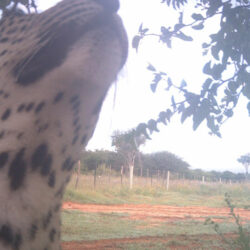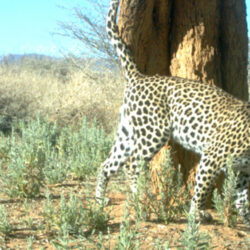Black Gold Mining in Gobabis
-

- by February 6, 2019

We left after lunchtime with CCF’s scat detection dog Ole on the backseat of the bakkie since the boot was full of equipment needed for our expedition. We were on a hunt for scat otherwise known as “black gold”. After some long hours in the heat of the African summer we arrived in Gobabis in the evening. We got to witness a beautiful sunset when we met Dr. Hanlie Winterbach. She is working for CCF on human wildlife conflict solutions in the Omaheke region. Dr. Winterbach accompanied us to our campsite where we put up our tents got some sleep after a delicious dinner.
On the first day, early morning after breakfast, we packed our tents and drove off to meet Hanlie at the town Centre. She knew the location of the farm. From the town centre we drove to her residence to collect some important tools to help us in the field such as a GPS and camera. We drove off to the farm which was more than 100 km from the town. The farm was chosen among other farms, as result of the high number of playtrees visited regularly by several cheetahs. The farm owner Hans-Wolf von Schumann is a German speaking Namibian livestock and game farmer. He knew the exact location of the playrees and was happy to help us to find them. It was a very exhaustive day but once we arrived at our final destination, we were so excited to get started working and so was Ole. It was a long drive but I was so excited as this was my first time on a farm with the scat dog team. I noticed how Ole jumped right into it. He began to work and we all followed.


Once in the field the search started and so was our work, when we located the first playtree it was very exciting and Ole indicated the first cheetah scat sample. From there we continued searching in the field and found 4 playtrees, each playtree was marked using a GPS and we collected as many scat samples as we could. One challenge was that the dog did not indicate on all samples and also we were unable to identify to which carnivore the scat belonged belongs if the scat had a lot of hairs. When it was dawn our working hours came to an end especially because thunder and lightning storms started to rise which was such a beautiful phenomenal to experience.
On the second day, after enjoying the accommodation and the heartwarming welcome of Mr. Hans-Wolf von Schumann and his family. We were very excited to wake up early in the morning and we enjoyed a beautiful view of the sunrise and listened to the sweet melodies of song birds and of course with a cup of hot coffee. Once done with breakfast, it was time for work, we drove into the field, and this time we were joined by the owner Mr. Hans-Wolf von Schumann. When we arrived in the bush we started searching for possible play trees to find scat and also possible hair samples. Hanlie was very interested to find out to which animal the hair belongs to but of course that will only be known after the hair reading done back at CCF. We collected and marked every play tree and were the sample was collected from and it was so much exciting that while searching for the next play tree we came across a cobra which was very fascinating. Later that day Tim, Ole and I went into the field to search for any possible play tree without any assistance from people knowing the area. It was very unfortunate that we did not find any scat sample from all possible playtree we came across but it was a great experience for the scat detection dog team.
On the third day Tim, Ole and I went into the field, again with so much determination to find play trees with possible scat samples. We came back empty handed but it was still fine because on our first and second day we had collected many samples already. We were focused on doing better than our best. Later in the evening, we were again on the move and this time we were accompanied by “Wolfi”. It was cloudy but it did not stop us from doing our work. While in the field it started raining but still we jumped out of the vehicle and walked into the open woodland. We found and marked some tree locations even though we did not find scat samples on them. Finally, on the last playtree that we found it had a scat sample so we marked it and collected our sample which concluded our work for that day.
On the fourth day which was our last day, we went into the field after breakfast just to do a quick search for playtrees. We didn’t find any so we drove back and started packing to head back to Otjiwarongo. We were escorted by Wolfi until the last gate from where it was more than 100 kilometers drive to the main road. It was a great journey and experience for the scat dog detection team and making it back safely to Cheetah Conservation Fund in Otjiwarongo!





